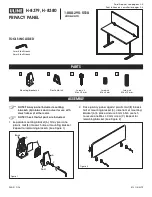
Eaton’s Crouse-Hinds Business
Cooper Crouse-Hinds Pte Ltd
No. 2 Serangoon North Ave 5 #06-01
Singapore 554911
tel: + 65 6645 9888
fax: +65 6297 4819
Page 34
Peak low/in-band/high frequency noise
Peak noise in the respective frequency band detected by the diagnostic module over
the last hour. Note that noise levels only have upper limits, as only high noise
represents a problem. The lower the noise, the better.
Default limit values are:
Frequency band
PreAlert limit (High limit)
Alert limit (High-high limit)
Low frequency
65535 mV
65535 mV
In-band frequency
(=fieldbus frequency)
65535 mV
65535 mV
High frequency
65535 mV
65535 mV
What is the difference between peak noise and average noise?
A peak value can be understood as a spike. If only once in a while a spike occurs, you
may have some high values for the peak noise level, but if at other times the noise is
low, the average value would still remain low.
A peak noise value exceeding the fieldbus specification limits may be able to disturb
the communication, but only for a short period of time. Examples of such peaks are a
lightning strike, a machine switching on/off, or a maintenance person causing an
accidental short circuit at a field device. As a result, a data transmission may be
corrupted, but the fieldbus protocol is designed to tolerate such disturbances, so that
the bus itself will continue to operate without any problem at all.
However, if the source of noise is of permanent nature, such as a VSD/VFD (variable
speed/frequency drive), and for some reason such noise is able to impact on the
fieldbus cable (e.g. if unshielded cable is used), the peaks will occur permanently, and
as such the average value will be significantly increased. If this condition remains,
fieldbus could be disturbed permanently.
As such, it should be understood that average noise levels are more critical, and hence
average noise limits should be set lower than peak noise limits.
















































